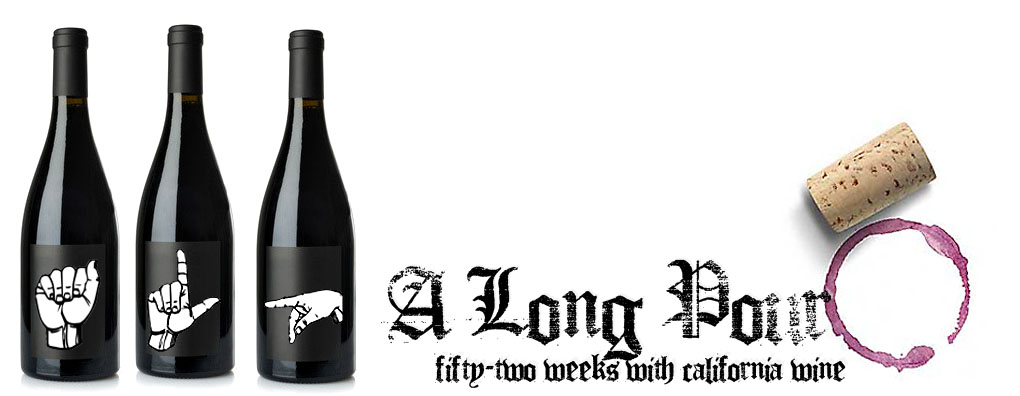Kunin – Middle Chapters
Seth Kunin looks like the perfect Santa Barbaran. On a recent visit with him, he wore a dress shirt with the sleeves cuffed half way up his forearm, shorts, and Converse sans the laces and socks. He wears a short white beard and glasses. In Santa Barbara he could be a lawyer, a billionaire entrepreneur, a tech company CEO, or unemployed. His laid back dress is typical of Santa Barbara men’s fashion and is a reflection of his calm and collected personality.
Seth and his wife Megan pour and talk about their Kunin Wines from a sun filled tasting room a few blocks from the beach. It is an inviting space. In the back, a grid of shelves display neat rows of their wines; which are mostly Rhône varietals. In the front, there are several toys for their young daughter Phoebe. The tasting room, which until recently was shared with Westerly Vineyards, sees over 1,000 tasters a month, from locals to Los Angeles based beach goers and mustached hipsters.
 The tasting room is part of a region called the Urban Wine Trail; which consists of a half dozen wineries in the blocks surrounding the original urban player Santa Barbara Winery. You can now sample some of the best wines from all over Santa Barbara County while in your bikini or board shorts. The location, close to downtown Santa Barbara and the beach makes for an eclectic mix of tasters, from seasoned veterans to those having their first experience. There are the occasional groups of drunken bachelorette parties and many interesting conversations to overhear. There are always fun people to watch.
The tasting room is part of a region called the Urban Wine Trail; which consists of a half dozen wineries in the blocks surrounding the original urban player Santa Barbara Winery. You can now sample some of the best wines from all over Santa Barbara County while in your bikini or board shorts. The location, close to downtown Santa Barbara and the beach makes for an eclectic mix of tasters, from seasoned veterans to those having their first experience. There are the occasional groups of drunken bachelorette parties and many interesting conversations to overhear. There are always fun people to watch.
Santa Barbara and similarly minded cities all over the country are seeing a revitalization of food accessible culture. Many champion the “eat local, drink local” mantra and for Santa Barbara, you don’t get any more local than the Urban Wine Trail. While for Seth, the location offers a tasting room close to his Santa Barbara home and his boat at the harbor, it also puts him at the center of a shift in the American mentality towards wine.
For centuries, many in places, like France, have included locally produced wine and other food in their everyday lives. In America, we reserved wine for special occasions, not for the everyday, and most of it came from California or the usual European suspects. Our food, especially in urban settings, came from a supermarket that got it from…’who cares where they got it from, I’m an American, why would I care where my food comes from?’
Increasingly, people do care where their food comes from (eggs anyone?), as well as their alcohol. Like many small villages in  France, Santa Barbara offers the opportunity to pick up a bottle or two from any number of producers and enjoy it with a dinner prepared from local produce. The growing support of farmers markets, food co-ops, and even CSA’s (crop share agreements) throughout Santa Barbara and the entire Country allow for a closer connection with the food we eat and the wine we drink, and savvy winemakers want to be at the middle of the movement: hence, urban wineries and tasting rooms.
France, Santa Barbara offers the opportunity to pick up a bottle or two from any number of producers and enjoy it with a dinner prepared from local produce. The growing support of farmers markets, food co-ops, and even CSA’s (crop share agreements) throughout Santa Barbara and the entire Country allow for a closer connection with the food we eat and the wine we drink, and savvy winemakers want to be at the middle of the movement: hence, urban wineries and tasting rooms.
Like a British pop-star ( hi Amy, hi Pete), Seth’s wines can be a bit wild and uncontrolled. Unlike Britain’s substance friendly musicians, the style of Kunin wine is a result of Seth’s light hands in the winemaking process. It starts with his definition of a quality wine: “Great wine should be a reflection of the varietal it’s made from and the place that it came from,” he says when asked if he has a wine philosophy. “I age my wine a very short time in the barrel, because I want the wine to taste like the grape and vineyard. The longer the wines stay in barrel the more it tastes like a barrel and the less it tastes like a vineyard.” For Seth, an Alisos Vineyard Syrah should first be true to the character of Syrah, but also reflect the unique terroir of the vineyard.
Seth sets a focus on a simple winemaking approach. Harvest grapes, press them, add yeast, then barrel the juice. The short barrel time allows Seth to capture the quality of the grape in the bottle. “If I let it sit in the barrel longer I would be dumbing down the vineyard…To me it’s like, let it turn into wine then get it into the bottle.”
Many wine articles revolve around a series of facts (and are horribly written. You read A Long Pour, so you are familiar with horrible writing). Facts have a place: Seth Kunin is from New York, he left Manhattan to go to UCLA, he left L.A. for a role as General Manager of the praised Wine Cask for Doug Margerum in 90′, he worked harvests at Gainey starting in 96′, he started his own brand in the late 90’s, he was winemaker for Westerly until the harvest of 08, he believes in terroir and the expression of the grape. They are important, true, but there is more to a story than a list of facts.
In Seth’s case, his story and the story of his wine is only half written. The real story will unfold over the coming decades as he fine tunes his craft and gains deeper insight into the region and its vineyards. It is the same for Santa Barbara County. The story of Santa Barbara wine has some good opening chapters and it is starting to develop its themes and sub-plots, there is even a villain or two in the mix (that’s another story). But no one knows where the story will go and how it will end. But, there is a lesson in Kunin Rosé.
Kunin produces two Rosés that both carry the name Phoebe (beautiful goddess). “We started making Rosé in 06’ and we named it after my grandmother, Phoebe. Then in 09’ we had a baby and we named her after her great-grandmother, Phoebe. So then we made two Rosés in 09’ and we were going to blend them together, but it didn’t really work. So we had two Rosés. So we named them both Phoebe. There is “Phoebe,” and then there is “Phoebe 2.0.”
Like Seth’s Rosé, there are two Phoebe’s of Santa Barbara County wine. There is the Phoebe of tradition, the one that reminds us of how we got where we are and grounds us to our past. Beautiful in experience, this Phoebe can offer a wisdom that comes only from time. She has been central to our story from the start and will continue to be so. It is this Phoebe that is reflected in the producers who make wines influenced by the great wines of Burgundy and Rhône. It can be seen in producers like Richard Sanford or Ken  Brown who have enough decades in Santa Barbara under their belts to provide solid foundations for others to build on. All of these carry with them a tremendous respect for the craft of winemaking and its rich tradition. Like a grandmother, the combined knowledge of those who came before helps guide us, so that we might gain from their experience and build upon that inherited knowledge.
Brown who have enough decades in Santa Barbara under their belts to provide solid foundations for others to build on. All of these carry with them a tremendous respect for the craft of winemaking and its rich tradition. Like a grandmother, the combined knowledge of those who came before helps guide us, so that we might gain from their experience and build upon that inherited knowledge.
There is also Phoebe 2.0, young and beautiful in youth, uninhibited by tradition, a blank surface on which future vintages will carve and shape what she becomes. This Phoebe will take some of her traditions from those who came before. She will also create her own traditions, building on the foundations forged before her. With new varietals being explored, new techniques being perfected, and young winemakers eager to push boundaries, Santa Barbara can be said to be a blank slate. Once the sculptor has prepared his base, the painter his canvas, or the carpenter his foundation, the work of creating a unique expression can begin.
Santa Barbara is at the intersection of the two Phoebes. Old enough to possess the wisdom of time, but young enough to not yet know where the story ends. I see it in winemakers like Nick de Luca, Ryan Carr, Dave Potter, and I see it in Seth. Some will be more dedicated to tradition, while others will work to rewrite the way we think about wine and Santa Barbara. All will tell their story over decades, adding a chapter with each vintage.
“It’s a young region,” he points out when asked how Santa Barbara will stack-up over time. “The first vines were only planted here 40 years ago. People are still getting to know it. A lot of the winemakers here didn’t go to [UC] Davis, a lot of them are locals learning by doing. Even if they are Davis trained, every place has its nuances. You need to spend some time making wine in a place before you feel you have a handle on it.”
His conclusion? “It’s only going to get better.”
Seth has proven himself a smart and adept winemaker, but his story is only half told. Like the others, he will be figuring out his craft for many years to come. Maybe one day, when Phoebe is off in college, or working in the family business, Seth can finally sit down with someone and say, “this is my story and the story of my wine.”
28 Anacapa Street
Santa Barbara, CA. 93101
805.963.9633
Seth makes a Châteauneuf–du–Pape inspired blend he lovingly calls Pape Star. It is one of the finest Santa Barbara wines I have found this year and at about $22 it’s a great buy.



[…] Kunnin Pheobe Rose, Larner Vineyard SYV […]